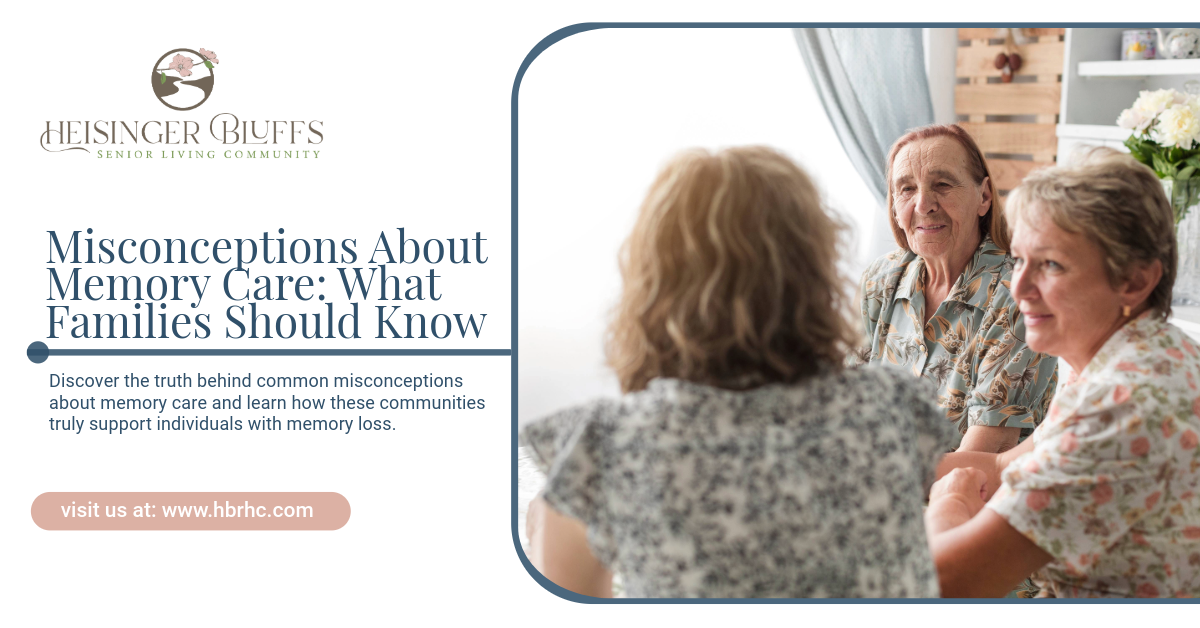Misconceptions About Memory Care: What Families Should Know

Memory care is a specialized type of senior living designed to support individuals with Alzheimer’s disease, dementia, or other memory-related conditions. Yet, despite its growing importance, memory care is often misunderstood. Many families are unsure about what to expect or are hesitant to consider memory care due to widespread myths and misconceptions.
This blog aims to clear up the confusion by addressing the most common misconceptions about memory care, highlighting the true benefits, and offering clarity for families navigating care options for a loved one.
What Is Memory Care?
Memory care is a form of long-term care tailored to meet the needs of seniors experiencing cognitive decline. These communities offer 24/7 support, structured routines, specialized therapies, and secure environments. Staff members are trained to communicate effectively with individuals experiencing memory loss and are skilled in managing behavioral symptoms associated with dementia.
The goal of memory care is not just safety, but dignity, comfort, and quality of life.
Top Misconceptions About Memory Care
Misconception #1: Memory care is the same as a nursing home
Reality: While both provide care for older adults, memory care and nursing homes serve different purposes. Memory care is designed specifically for individuals with Alzheimer’s and other types of dementia. It features staff with specialized training, structured daily routines, and dementia-friendly activities. Nursing homes, on the other hand, focus on medical care for individuals with complex health conditions, often unrelated to memory loss.
| Feature | Memory Care | Nursing Care |
|---|---|---|
| Primary Focus | Cognitive support | Medical care |
| Environment | Secured, structured | Clinical |
| Staff Training | Dementia-specific | General nursing |
| Activities | Memory-enhancing, structured | Basic recreation |
Misconception #2: People in memory care are sedated or isolated
Reality: This outdated image is far from the truth. Modern memory care communities focus on enriching residents’ lives, not limiting them. Residents participate in a variety of engaging activities, such as music therapy, art classes, pet visits, gardening, and social events. Medication is used thoughtfully and only when necessary, often in conjunction with behavioral strategies and calming environments.
Misconception #3: Memory care takes away independence
Reality: Memory care promotes as much independence as possible. While staff members are always available to assist, residents are encouraged to do what they can on their own. The environment is designed to reduce confusion and increase autonomy—features like clearly marked rooms, visual cues, and simple layouts empower residents to navigate their surroundings safely.
Misconception #4: It’s only for the late stages of dementia
Reality: Memory care can be beneficial at all stages of dementia, not just the later ones. In fact, early intervention can improve quality of life and slow cognitive decline. Residents at earlier stages benefit from cognitive stimulation, social engagement, and therapeutic programs that help maintain skills for as long as possible.
Misconception #5: Memory care is unaffordable for most families
Reality: While memory care is an investment, there are several ways to make it more accessible. Many communities offer flexible pricing options, and financial assistance may be available through long-term care insurance, veterans’ benefits, or Medicaid programs (depending on eligibility). Plus, the all-inclusive nature of memory care, housing, meals, medical monitoring, therapies, often consolidates costs families might otherwise pay separately.
Misconception #6: Families are no longer involved once a loved one moves in
Reality: Memory care communities actively encourage family involvement. From family support groups and care planning meetings to regular visits and community events, family members are considered essential partners in care. Many communities also offer educational sessions to help families understand dementia and learn how to support their loved one emotionally and practically.
Misconception #7: Residents don’t form meaningful relationships in memory care
Reality: Although dementia affects communication and memory, individuals in memory care often form deep and meaningful relationships—with staff, fellow residents, and their family members. Consistent routines, familiar faces, and shared experiences promote social connection and emotional security.
Misconception #8: Memory care is too structured and restrictive
Reality: Structure in memory care provides predictability and reduces anxiety. Routines help residents feel more in control and reduce confusion. However, within that structure, there’s still flexibility and choice. Residents choose their meals, activities, and how to spend their time, all within a safe and supportive framework.
Misconception #9: Memory care doesn’t improve quality of life
Reality: Quality of life is one of the primary goals of memory care. With professional support, individualized care, and daily engagement, residents often experience reduced agitation, improved sleep, and greater emotional well-being. Families frequently report improvements in their loved one’s mood, behavior, and general outlook after moving into a memory care setting.
Misconception #10: Home care is always a better alternative
Reality: While home care can work for some families, it’s not the best option for everyone. Home care may lack the 24/7 supervision, therapeutic activities, social interaction, and secure environment that memory care communities provide. Caregiver burnout is also a real concern. Memory care can relieve the burden on families while providing specialized, consistent support that’s difficult to replicate at home.
The Benefits of Memory Care
Once families move past the misconceptions, many come to appreciate the true advantages of memory care. These include:
- 24/7 care from dementia-trained staff
- Safe and secure environments
- Daily memory-focused activities
- Medical oversight and medication management
- Nutritious, dementia-friendly meals
- Social opportunities and emotional support
- Lower caregiver stress and peace of mind for families
What to Look for in a Memory Care Community
When exploring memory care options, it’s important to focus on the quality of care, staff training, environment, and engagement opportunities.
Key Factors to Consider:
- Staff-to-resident ratio
- Experience and credentials of caregivers
- Safety features (secured doors, emergency systems)
- Personalization of care plans
- Family communication and involvement
- Variety of daily activities
- Cleanliness and design of the community
- Resident and family testimonials
Taking a tour, meeting staff, and observing interactions can help determine whether a memory care community feels right for your loved one.
Final Thoughts
Misconceptions about memory care often prevent families from considering a supportive, enriching solution for their loved ones. By understanding what memory care truly offers, specialized care, a secure yet empowering environment, and a holistic approach to wellness, families can make informed decisions that honor their loved one’s dignity and promote the best possible quality of life.
Heisinger Bluffs offers a dedicated memory care program built around compassion, safety, and person-centered care. If you're exploring options for a loved one with memory loss, their team can guide you through the process and help you find the right fit. Reach out to us today!
Frequently Asked Questions
When should a person with dementia move to memory care?
A move to memory care is often appropriate when safety becomes a concern, daily tasks become overwhelming, or behavioral symptoms begin to impact quality of life for the individual or their family.
Is memory care only for people with Alzheimer’s disease?
No. Memory care supports individuals with various types of dementia, including Alzheimer’s, vascular dementia, Lewy body dementia, and other cognitive impairments.
Can I visit my loved one in memory care anytime?
Most communities welcome regular visits and have flexible visiting hours. Some may have safety protocols in place, so it’s best to check with the specific community for guidelines.
Sources:
- https://www.ncbi.nlm.nih.gov/books/NBK551552/
- https://www.alzheimers.org.uk/about-dementia/types-dementia
- https://www.mayoclinic.org/diseases-conditions/dementia/diagnosis-treatment/drc-20352019
- https://www.alz.org/help-support/caregiving/financial-legal-planning/medicaid
- https://www.betterhealth.vic.gov.au/health/conditionsandtreatments/dementia-communication
- https://www.alzheimers.org.uk/get-support/publications-and-factsheets/dementia-together/book-recipes-cooking-ideas-people-affected-dementia











